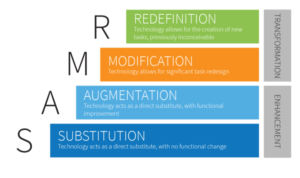I choose the SMAR model to evaluate the H5P interactive video I created last week. The SAMR model is a framework created by Dr.Ruben Puentedura and this model classifies four different levels of classroom technology integration. As shown in the figure below, the letters “SMAR” stand for substitution, augmentation, modification, and redefinition. Substitution and augmentation are considered as “enhancement” steps, while modification and redefinition are called “transformation” steps. In my opinion, the H5P interactive video belongs to the augmentation step. Augmentation means that technology acts as a direct tool substitute, thereby adding functional improvements to the activity. In my H5P interactive video, the audience needs to answer some questions while watching the video. This interactive way of letting the audience answer questions while watching the video is basically the same as the way that the teacher asks students some questions after the video is played.
Compared with the SECTIONS framework, the SMAR framework can be a simple and effective method for evaluating how educators integrate technology into their teaching. In the SMAR framework, educators only need to meet the requirements of the corresponding step according to their own needs.
There are two multimedia principles relate to the H5P interactive video, and they are principles of spatial and multimedia.
Spatial principle: the questions raised in the H5P video are directly related to the content of the video at that time. For example, when I introduce what types of videos TikTok includes in the video, the audience needs to answer what types of videos they like to watch on TikTok.
Multimedia: The video contains not only include graphics, but also text.

(Image Modified from Original by Lefflerd’s on Wikimedia Commons)
from: https://www.schoology.com/blog/samr-model-practical-guide-edtech-integration


Recent Comments